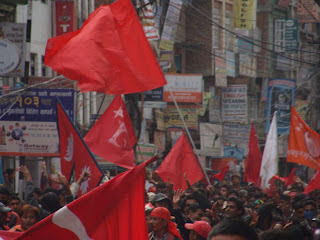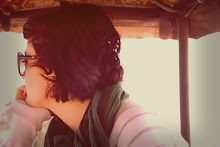There has been a lot of news coming out for the past week about Nepal and the Maoists. I don’t think I will be giving a complete view of all the elements, that is probably unavoidable, plus I have to say that as I’m living in my little bubble, in Raksha shelter, I only got news about these facts from the internet and from talking to the staff or other people I find on the way.
The 2008 elections gave the Maoists a majority in government and, after a 240-year reign, the monarchy was abolished. The Nepali President Ram Baran Yadav, fearful of too much Maoist power, refused to have former Maoist rebels incorporated into the armed forces. This led to Prachanda’s (maoist leader and brand new prime minister) resignation on 4th May.
Since then, the Maoists accuse the government of violating the rights of the population. The Unified Communist Party of Nepal (Maoist) UCPN (M) claims to have innumerable reasons to declare their second round of protest programs which started on the 1st of November. The 45-point manifesto addresses a range of issues, including social and economic reform, the restoration of “civilian supremacy”, the fall of the puppet government, and state restructuring and peace process-related issues such as the integration of the two armies and the social inclusion of traditionally marginalized groups. Their detractors however, see that the sole reason for the UCPN(M) is to shake the country and thereby grab power.
Due to the prolonged political crisis prevailing in the country, Nepal is now in the position of becoming a failed state, something that the political leaders here have not seriously accepted as reality. Besides, if Maoists perpetuate their movement to capture the state with these urban uprisings maybe the nation will not be able to avoid a “political accident” that might drag it into a failed state.
However, Prachanda said that his party was still committed to the conclusion of the peace process and for the draft of the new constitution on time.
The most significant achievement of the peace process to date has been the election of a representative Constituent Assembly. Its central task, and arguably the country’s most important challenge, is to draft a new constitution, for promulgation by 28 May 2010. With just over half of the thematic concept papers having been debated by the Assembly, the overall schedule has been revised for the sixth time. The stabilisation of the country depends on this first step. “The vociferous Tiger has already tasted the Human Blood, it will come back again and pounce”, this is the conclusion of the observers.
For the Chief of United Nations Mission in Nepal (UNMIN) Karin Landgren, the peace process is still unfinished business. She puts emphasis on the recommendation of the establishment of a “more formal dialogue mechanism to streamline negotiations and find creative solutions to overcome the current impasse”, while trying to avoid from all parts “provocative statements or actions in order to maintain a positive climate for dialogue”.
Today it seems that no public transport is allowed on the road, in the morning there were some courageous drivers who made the costumers pay double for the ride, until they found the pickets and were forced to stop. Some of the staff can’t arrive to the office… but at least bandhaa has not been declared, and we don't have to stay at home, not allowed to go in the streets, and running out of fresh supplies –for the moment-.

and we can still profit from watching kathmandu valley going darker and darker until night falls...
 Maoists picketed Singha Durbar, the main administrative area of Nepal, which had never been picketed before. People making music in the streets, everybody was dancing, clapping hands, or screaming and making noise, more than a protest, it looked like a carnival! One important fact is that they respected the peaceful protest they meant.
Maoists picketed Singha Durbar, the main administrative area of Nepal, which had never been picketed before. People making music in the streets, everybody was dancing, clapping hands, or screaming and making noise, more than a protest, it looked like a carnival! One important fact is that they respected the peaceful protest they meant.
 this was the last day of the second round of protests, “We want the government to address our demands in a week or else face a more aggressive agitation,” said former Prime Minister and chairman of UCPN-Maoist Pushpa Kamal Dahal ‘Prachanda’. We will see what the next move from the government is. We all know that if both sides stay rigid with their ideals, nothing will move onwards. The ruling coalition and the maoists must somehow agree on a few basic things including these two hot issues: constitution making and the peace process. Let's hope this happens before the population gets hurt one again, what could remember the hard years of civil war they had to go through some time ago.
this was the last day of the second round of protests, “We want the government to address our demands in a week or else face a more aggressive agitation,” said former Prime Minister and chairman of UCPN-Maoist Pushpa Kamal Dahal ‘Prachanda’. We will see what the next move from the government is. We all know that if both sides stay rigid with their ideals, nothing will move onwards. The ruling coalition and the maoists must somehow agree on a few basic things including these two hot issues: constitution making and the peace process. Let's hope this happens before the population gets hurt one again, what could remember the hard years of civil war they had to go through some time ago.








